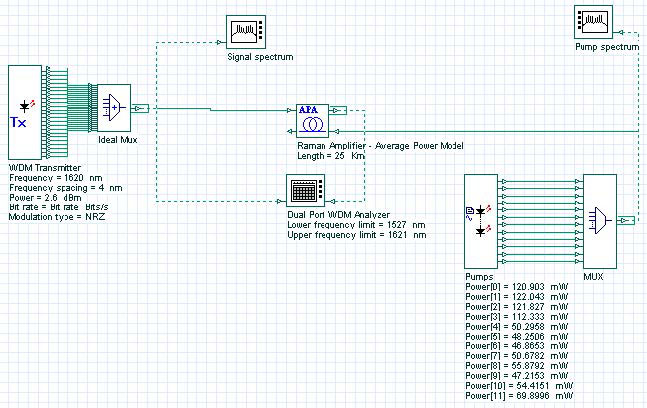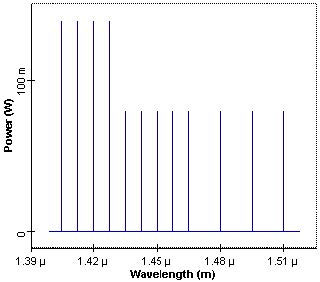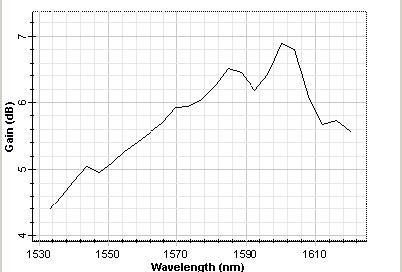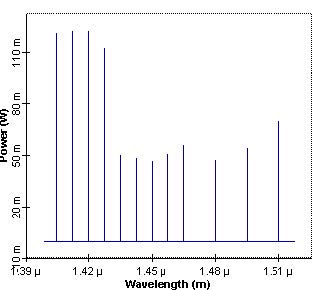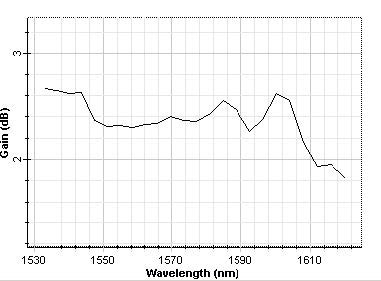In this lesson, we will use the gain flattening type of optimization to optimize the pump powers for flattening the gain of a Raman amplifier.
Fiber Raman amplifiers are recently getting much more attention in WDM systems due to their greatly extended bandwidth and distributed amplification with the installed fiber as gain medium [1]. It has been shown that the bandwidth of the amplifier can be further increased and a better gain flatness can be obtained by using more than one pump at different wavelengths [1]-[9]. In this example, we use optimization of pump powers to design a gain-flattened Raman amplifier by using 12-wavelength-channel WDM LD unit. We also compare the simulation results with the experimental findings of [9].
The project is BroadBand Flat Gain Raman Amplifier Average Model.osd. The project layout is as shown in Figure 1. Channels are between 1528 and 1620 nm with 4 nm separation, and average power of each channel is 0 dBm. The fiber used as gain medium is a 25 km SMF fiber with 9.9e-014 m/W peak Raman gain coefficient. A 12 wavelength-channel WDM high power pump LD unit is used for pumping. The spacing in the short wavelength section (Pump I) (1405-1457.5 nm) is 7.5 nm (~1 THz). The spacing in the long wavelength section (Pump II) (1465-1510 nm) is 15 nm (~2 Thz).
Figure 1: Raman amplifier with multipump configuration
To set up the optimization, you need to insert a new MPO Optimization into the project. Then you need to select the Gain Flattening type of optimization in the Main tab. Finally you need to add the pump powers in the Parameters tab and Gains in the Results tab.
In this example, we will show how much flatness you can get before optimization and after optimization. In the Parameters tab, after adding pump powers to the selected list, starting pump powers are selected to be 140 mW for the first 4 pumps, and 80 mW for the remaining. Minimum and maximum pump powers are selected to be 20 mW and 160 mW, respectively.
Figure 2 shows the initial pump power spectrum.
Figure 2: Initial pump power spectrum
With this pump configuration we observed the gain shown in Figure 3. The obtained gain flatness was 2.5 dB, maximum gain was 6.9 dB.
Figure 3: Gain and noise figure spectrums before the optimization is applied
We selected the Gains for all channels from Dual Port WDM Analyzer in the Results tab of the optimization tool. You can easy do this by selecting multiple results from the results browser and adding them to the selected list.
Target gain is 3.0 dB as inserted in Target Value of this tab. Number of Goals to Achieve Exactly is same as the number of channels. This is automatically done when you add each result to the selected list and you can not change this value for Gain Flattening type of optimization.
In the Constraints tab, Ratio Max/Min Gain (dB) from the Dual Port WDM Analyzer is selected and added to the Constraint list. To do so, go to the Constraint tab and click Add, and in the New Constraint window, select Bind Result type and click OK.
In the Select Results window, add Ratio Max/Min Gain (dB) from Dual Port WDM Analyzer. As a constraint, gain flatness < 1.5 dB is required. Enter this on the Constraint tab by selecting Less than option.
Note that no unit for parameters and results is indicated in the optimization tool. The units of parameters and results in the optimization tool are taken to be same as the ones that are given in the project layout for the corresponding parameter or result.
The optimization parameters in Advanced tab are as follows: Result Termination Tolerance is 0.1, Constraint Termination Tolerance is 0.1, and Parameter Termination Tolerance is 0.05.
After setting up the optimization, run the optimization.
Note: It may take up to 20 minutes to get the results.
Optimum pump powers are obtained after 44 passes. The pump power spectrum after the optimization is shown in Figure 4. Note the agreement of pump power allocation with the experimental findings of [9].
Figure 4: Optimized pump power spectrum
Gain spectrum, in this case, is shown in Figure 5. Gain flatness achieved in [9] was ~1 dB (** 0.5 dB). We have observed somewhat better gain flatness, compared to this value. After the optimization, achieved forward gain flatness is 0.8 dB and maximum gain is 2.8 dB.
Figure 5: Gain as measured by Dual Port WDM Analyzer, after the optimization is applied
References:
[1]Mohammed N. Islam, “Raman amplifiers for telecommunications”, IEEE J. Select. Top. Quan. Elect. 8, 548 (2002).
[2]Y. Emori, et al., “Broadband flat-gain and low-noise Raman amplifiers pumped by wavelength-multiplexed high power laser diodes”, Opt. Fib. Tech. 8, 107 (2002).
[3]V. E. Perlin and H. G. Winful, “On distributed Raman amplification for ultrabroad-band long-haul WDM systems”, J. Lightwave Tech. 20, 409 (2002).
[4]V. E. Perlin and H. G. Winful, “Optimal design of flat gain wide band fiber Raman amplifiers”, J. Lightwave Tech. 20, 250 (2002).
[5]M. Yan, et al., “Automatic design scheme for optical fiber Raman amplifiers backward pumped with multiple laser diode pumps”, IEEE Photon. Tech. Lett. 13, 948 (2001).
[6]S. Namiki and Y. Emori, “Ultrabroad-band Raman amplifiers pumped and gain-equalized by wavelength division multiplexed high power laser diodes”, IEEE J. Select. Top. Quan.
Elect. 7, 3 (2001).
[7]P.C. Reeves-Hall, et al., “Dual wavelength pumped L- and U-band Raman amplifier”, Elect. Lett. 37, 883 (2001).
[8]Xiang Zhou, et al., “A simplified model and optimal design of a multi-wavelength backward pumped fiber Raman amplifier”, IEEE Photon. Tech. Lett. 13, 945 (2001).
[9]Y. Emori, et al., “100 nm bandwidth flat-gain Raman amplifiers pumped and gain equalized by 12-wavelength channel WDM laser diode unit”, Elect. Lett. 35, 1355 (1999).


